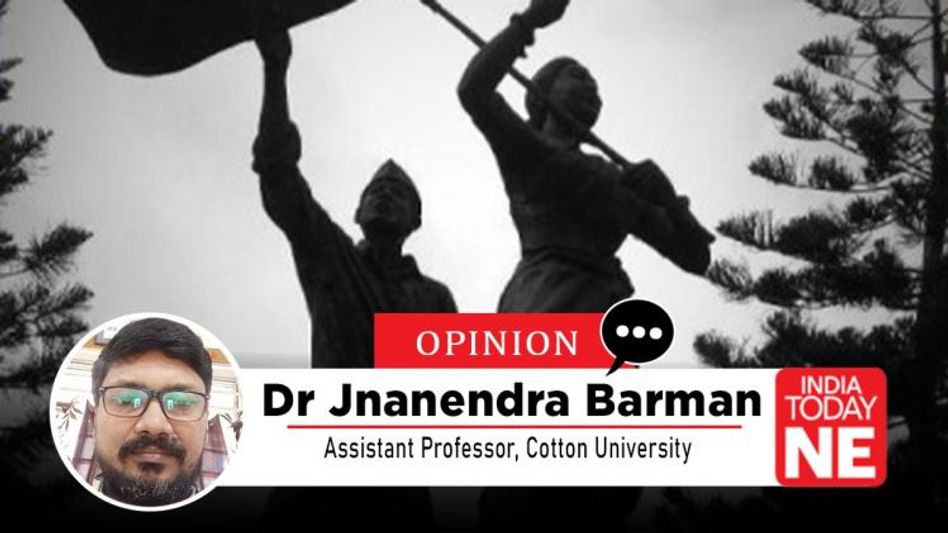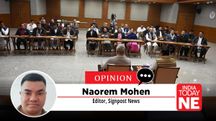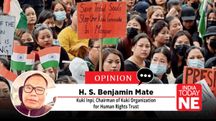“A Brief History of Freedom Struggle in Northeast of India(1498-1947): Amrit Manthan in Amrit Kaal
During the ‘Amrit Kaal’ when the entire nation is reasserting its ‘Swa’ (selfhood), it is pertinent to bring forth the contributions of the people who sacrificed their lives to bring ‘Amrit’(nectar) of freedom to the country.
 “A Brief History of Freedom Struggle in Northeast of India(1498-1947)
“A Brief History of Freedom Struggle in Northeast of India(1498-1947)During the ‘Amrit Kaal’ when the entire nation is reasserting its ‘Swa’ (selfhood), it is pertinent to bring forth the contributions of the people who sacrificed their lives to bring ‘Amrit’(nectar) of freedom to the country.
The struggle and sacrifices of the people at the margin remained neglected in the dominant socio-political discourse of the country for a long period of time after independence.
India’s northeast, known as the land of the rising sun, termed ‘ashta lakshmi’ by Prime Minister Narendra Modi remained at the margin not just geographically but also psychologically. Economic backwardness contributed to the further alienation of the people from the rest of the country. Without the history of the Northeast, the history of the country will remain incomplete.
Northeast has occupied a significant position in the cultural landscape of the country since the days of the Ramayana and the Mahabharata. After BJP came to power in Delhi, attempt has been made to turn the centre’s ‘look east policy’ into ‘Act East’ policy. Sincere attempt has been made to develop the entire Northeast into the country’s growth engine. The contribution of the Northeastern part of the country in nation-building is being recognized.
Also Read: Why this new book on India's northeast is a must read
The people of the Northeast, like the rest of the country, offered strong resistance to the British colonial force.
The history of the freedom struggle in Northeast India is the history of the struggle to assert its ‘swa’.
Sacrifice of the unsung heroes who laid down their lives to protect/ assert their ‘swa’ in the face of colonial aggression need to be remembered with reverence.
The history of resistance offered by the people of Northeast India has been brought forth by an erudite young scholar of the country, Anandita Singh.
A Brief history of Freedom Struggle in Northeast of India ( 1498-1947) by Anandita Singh published by Centre for North East Studies, New Delhi in 2023 presents the trajectory of Northeast’s political development from colonial to the postcolonial period. With the advent of Vasco da Gama at Calicut in 1498 and the Bengal Sultanate’s permission to the Portuguese settlement in Chittagong, colonizers made their presence visible in India. The Portuguese colonizers introduced the slave system in India. The British arrived on 24th August, 1608 ‘owing to the charter signed by Elizabeth I on 31st December 1600 that gave the East India Company the monopoly to trade with India.’
The Islamist invading force led by Mir Jumla attacked Assam in 1662.Frans Jansz van der Haiden (1638-81) of the Dutch East India Company accompanied Mir Jumla. The British occupied Assam in 1824 following the first Anglo-Burmese was. On 24th February, 1824 Assam was ceded to the British by Burma under the treaty of Yandaboo. The British with the mask of a benevolent ruler actually enslaved the native self. To quote Aime Cesaire, ‘ cultures trampled underfoot, institutions undermined, lands confiscated, religions smashed, magnificent artistic creations destroyed.’ People of all walks of life rose to revolt against British oppression. Anandita Singh, in her book has mentioned all the resistance offered by the natives.
Resistance offered by the Janjatis of Northeast India draws special attention. The Resistance offered by the Janjatis like the Nagas, Khasis, Garos, Jaintia, Kuki, Singphos, Kacharis, Tiwa, Dimasa shook the British empire in the Northeast. The failure of British expeditions on many occasion to take control over the entire region made them use a different apparatus: the church. Missionaries were encouraged to enter into the tribal regions and spread Christianity.
Education was also used as a tool to ‘create a class of persons, Indian in blood and colour, but English in taste, in opinions, in morals and in intellect…’ Different warriors like Ranima Gaidinliu, Theng Phakhri, Haipou Jadonang, Piyoli Phukan, U Tirot Singh Syiem, Bir Tikendra Jit Singh, U Kiang Nangbah fought bravely against British colonialism. Their fight was not just to thwart political domination, but also to protect indigenous culture from British hegemony.
Resistance offered by the natives of Northeast were not isolated cases; When ‘the first war of independence’ started in 1857 against the British, Maniram Dewan led the revolt against the British in Assam. He was later hanged by the British. When swadeshi movement was launched in the country , Ambikagiri Raychoudhury and Gobinda Lahiri organised the students of Assam and called upon the people of Assam to boycott foreign goods.
Kushal Konwar laid down his life in 1942.Kanaklata Barua, Mukunda Kakati, Kumoli Devi, Ratan Kachari, Hemoram Patar, Kolai Koch became martyrs. The Muslim League conspiracy to make Assam part of Pakistan was thwarted by the able leadership of Gopinath Bordoloi with the blessings of Mahatma Gandhi. Prior to this, Subhash Chandra Bose’s intervention in 1938 saved Assam from going into the hands of Muslim League.
Copyright©2025 Living Media India Limited. For reprint rights: Syndications Today









